1960s
Spinning off new capabilities, new directions

Thunderbird emblem with three distinct feathers was used from 1956-1970
1960
January 1, 1960
Sandia began studying projectiles moving through earth, or terradynamics
Sandia began studying projectiles moving through earth—a field it dubbed terradynamics—in pursuit of weapon designs that could successfully pass through different soil environments and operate underground.
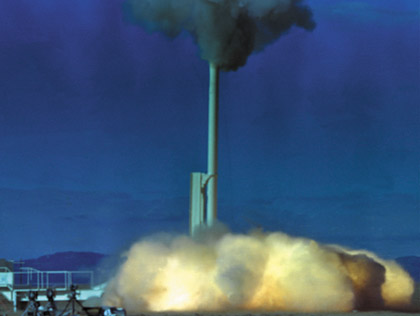
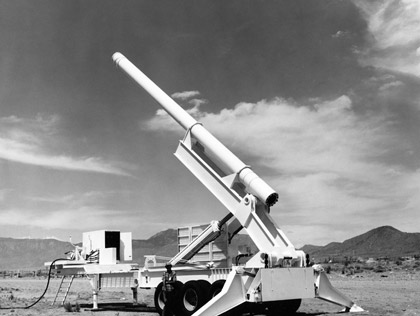
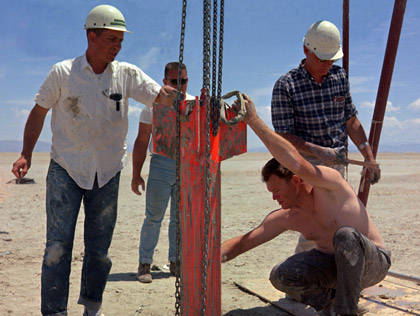
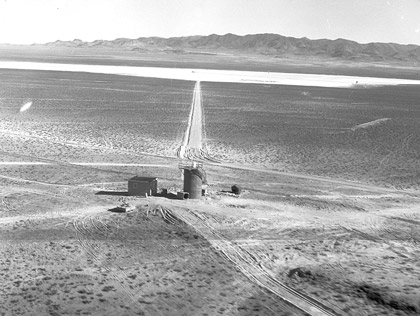
September 1, 1960
Tonopah Test Range replaced Salton Sea Test Base as Sandia’s test range
Originally selected in 1956 to support low-altitude test drops and rocket tests, the range was placed on Air Force land near Tonopah, Nevada. A series of dry lake beds running north-south provided natural targets and the weather was excellent for flying. Tonopah Test Range (TTR) operated in a campaign mode—with personnel coming from the Salton Sea Test Base to support specific test series—until 1960, when it was made Sandia’s permanent test range.
Aerial view of one of the early 30′ Contraves camera towers with a dry lakebed used as a target in the background in November 1956 when the Tonopah Test Range site was first in use.
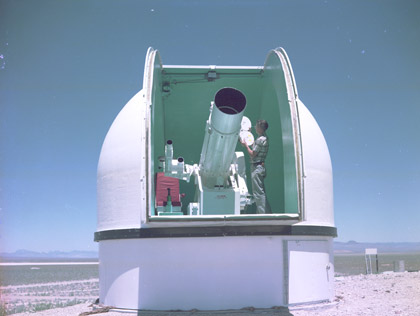
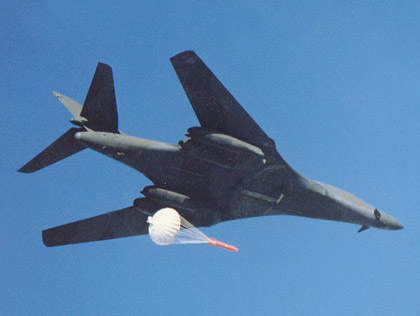
September 1, 1960
Siegmund P. “Monk” Schwartz became Sandia Corporation President
Monk Schwartz stepped into the Sandia presidency after having served as general manager under Jim McRae and Julius Molnar and thus brought a deep familiarity with the Laboratory’s operations and needs into his leadership. Contraction resulting from the US-UK-USSR nuclear test moratorium led to Sandia’s first layoffs, and Mr. Schwartz pushed for advanced research capabilities to keep the Laboratory looking and moving forward. He deftly engaged the White House on Permissive Action Link development and its required overseas deployment, a critical point in Sandia’s role in weapons safety. As the number of nuclear weapons systems in design dropped, Schwartz sought out special and reimbursable projects, including work for NASA and in support of U.S. efforts in Vietnam.
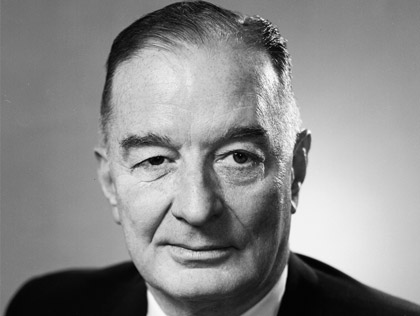
1961
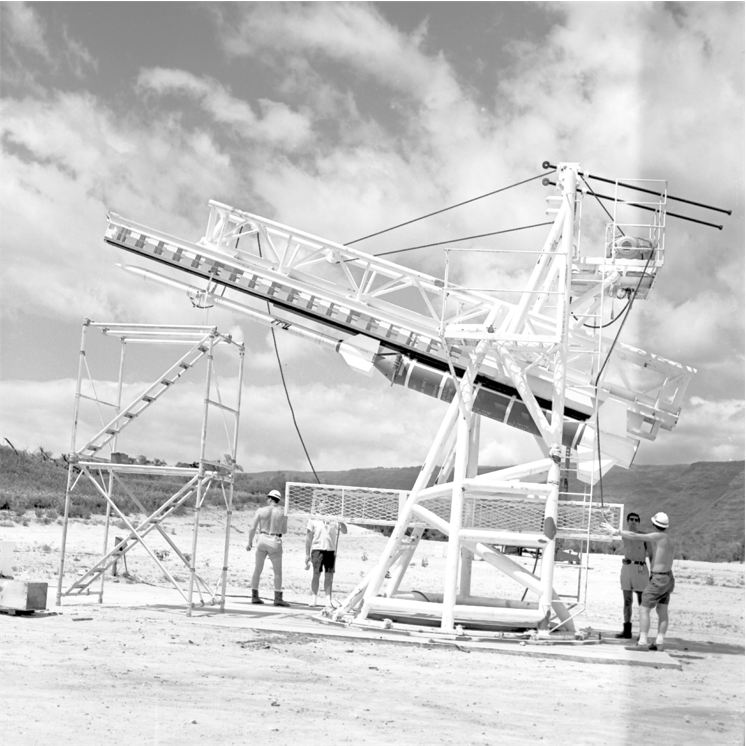
Sandia launches rockets in support of Operation Dominic from Kauai
With one day’s notice that it was ending the moratorium on nuclear testing, the Soviet Union fired a nuclear test shot on September 1, 1961. The United States immediately announced it, too, would resume testing and fired its first test on September 15 at the Nevada Test Site.
In addition to the underground tests at the NTS, in April 1962 the US announced it was beginning an atmospheric test series in the South Pacific. The Operation Dominic test series launched from and near Christmas Island and Johnston Atoll. Sandia established a test location at Barking Sands within Bonham Air Force Base on Kauai, Hawaii, to launch diagnostic rockets to measure effects of the Dominic shots. They brought in U.S. Army launchers and their own HAS launchers to launch instrumentation rockets; 68 Nike-Apache systems were launched from Kauai and 34 from Johnston Island during the test series.
After Dominic, Sandia continued to use the Kauai Test Facility. KTF was kept active in support of the Readiness requirements established by Congress in ratifying the Limited Test Ban Treaty in 1963. Readiness kept the US ready to begin atmospheric testing without delay, if necessary. Readiness ended in 1975; Sandia still uses KTF.
1962
January 1, 1962
Work starts on targeted warhead fully integrated with its reentry vehicle
Began work on an independently targeted warhead fully integrated with its reentry vehicle; subsequent contract from Navy for the Poseidon missile’s Mark 3 reentry body. In 1970, the completed design of the arming, fuzing, and firing package set new standards for miniaturization. Shown in the image, Sandia president Morgan Sparks (right) shows the arming fuzing, and firing module for the Poseidon to Director of Military Applications General Ernest Graves and Assistant Secretary of Army Norm Augustine, 1974.
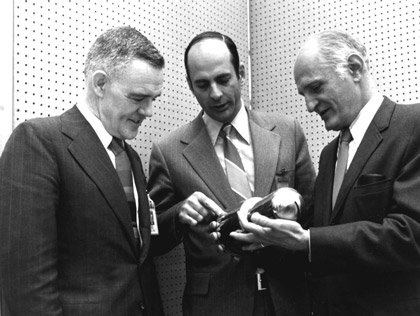
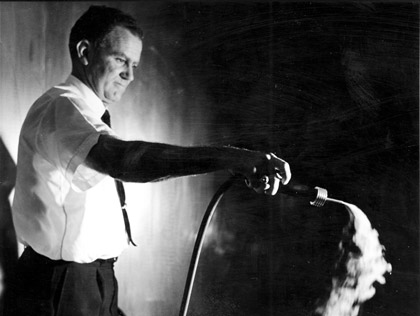
May 14, 1962
Atomic Energy Commission filed patent for Ultra-Clean Room
The Atomic Energy Commission filed a patent in the name of Sandia’s Willis J. Whitfield for the Ultra-Clean Room. U.S. Patent #3,158,457 was issued on November 24, 1964. Whitfield was assigned the problem of resolving manufacturing issues in close-tolerance parts in 1959. He developed the air flow concept—in which filtered air sweeps constantly through a workspace, resulting in about 10 changes of air per minute and continually cleaning the air of particulates. This was a significant improvement over existing clean room designs—sampling at the time indicated approximately 750 dust particles one-third of a micron in size or larger per cubic foot of air compared to average dust counts of more than 1 million particles per cubic foot of air in existing clean rooms. He and other researchers in his group developed both the clean room and clean workbench concepts, which were ultimately patented. They went on to participate in the development of Federal standards for clean room designs.
May 15, 1962
Sandia Engineering Reactor Facility opened for press tour after construction
The Sandia Engineering Reactor Facility (SERF), in Tech Area III opened for a press tour upon completion of its construction phase. SERF provided intense bursts of fast neutrons and gamma rays to use in radiation effects studies, in particular the effect of bursts and total doses of radiation on equipment.
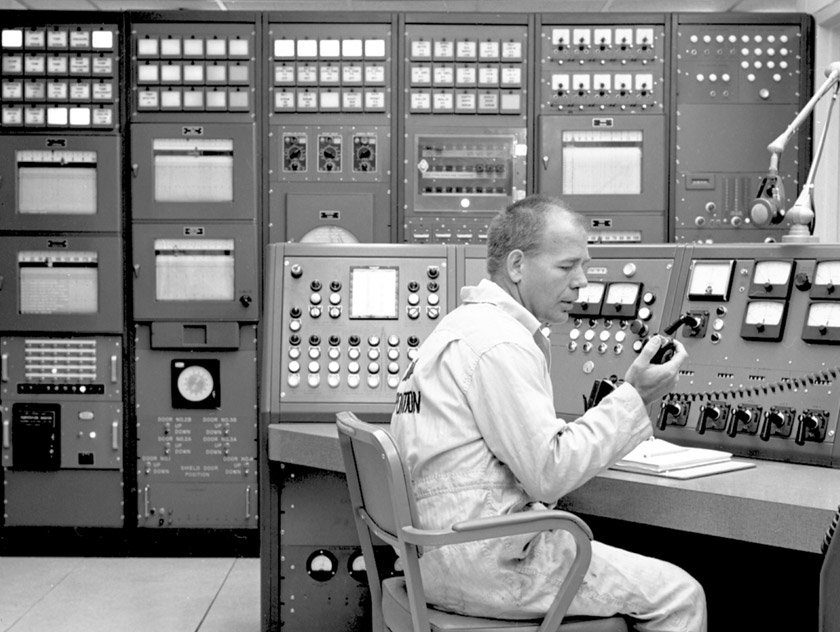
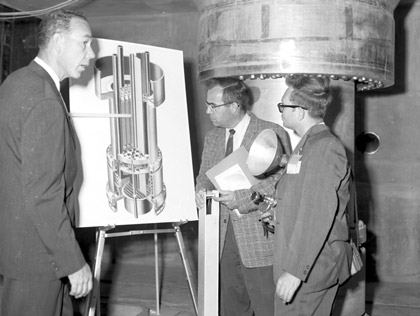
of SERF’s reactor core to newsmen Bob Brashear (center), of the Albuquerque Tribune & Bill Tucker of KOB-TV
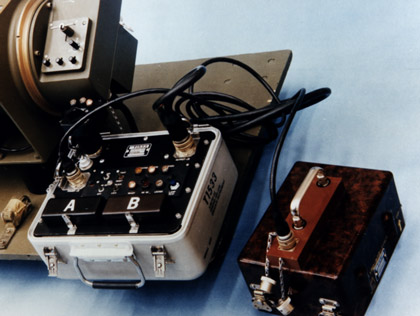
June 6, 1962
President issued Memorandum on Nuclear Weapons
President Kennedy issued National Security Action Memorandum No. 160 (Permissive Links for Nuclear Weapons in NATO) requiring Permissive Action Links (PAL) on all nuclear weapons, “now dispersed and to be dispersed to NATO commands”. It further instructed the Chairman of the Atomic Energy Commission and the Secretary of Defense to pursue with urgency research on advanced permissive link devices. Sandia originally developed the PAL in 1960 to prevent unauthorized use of nuclear weapons. After NSAM 160 was issued, the Lab pursued advanced PAL options.
July 9, 1962
Strypi rocket carried test device in high-altitude nuclear weapons test
Sandia developed the Strypi rocket that carried the test device in the Starfish Prime high-altitude nuclear weapons effects test.
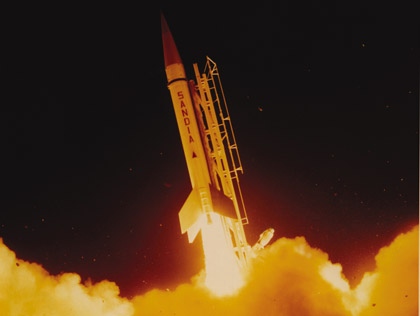
December 7, 1962
President John F. Kennedy visited Sandia’s New Mexico site
During his tour, he received a briefing on the Lab’s technical programs and toured the weapon training program in Building 892.
1963
March 1, 1963
Phase 3 work authorized on B-61, lightweight tactical thermonuclear bomb
Received Phase 3 authorization for work on a new lightweight tactical thermonuclear bomb, identified as the B61. Incorporating laydown delivery capability and everything that had been learned as laydown was developed, the B61 was a multipurpose weapon that became a workhorse in the stockpile, with multiple modifications added over the years.
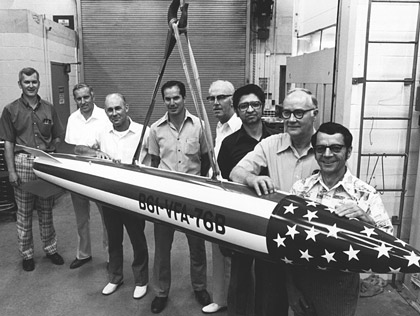
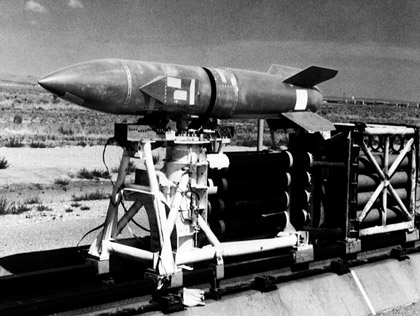
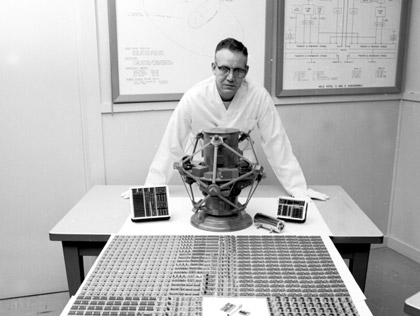
October 17, 1963
First pair of Vela satellites launched to monitor and detect nuclear detonations
In a joint program with Los Alamos National Laboratory, Sandia worked to develop and install optical sensors as well as data processing, logic, and power subsystems. Initially developed during the US-UK-USSR nuclear test moratorium and launched a week after the Limited Test Ban Treaty was signed, the Vela satellites were conceived and deployed completely for nuclear detection.
1964
August 1964
Special Atomic Demolition Munition enters stockpile
The great variety of nuclear weapons entering the stockpile in the late 1950s and early 1960s included several tactical weapons, most for the U.S. Army. One example of these was the B54 Special Atomic Demolition Munition (SADM), which was small enough to be carried by one individual. It was in the stockpile 1964-1989.
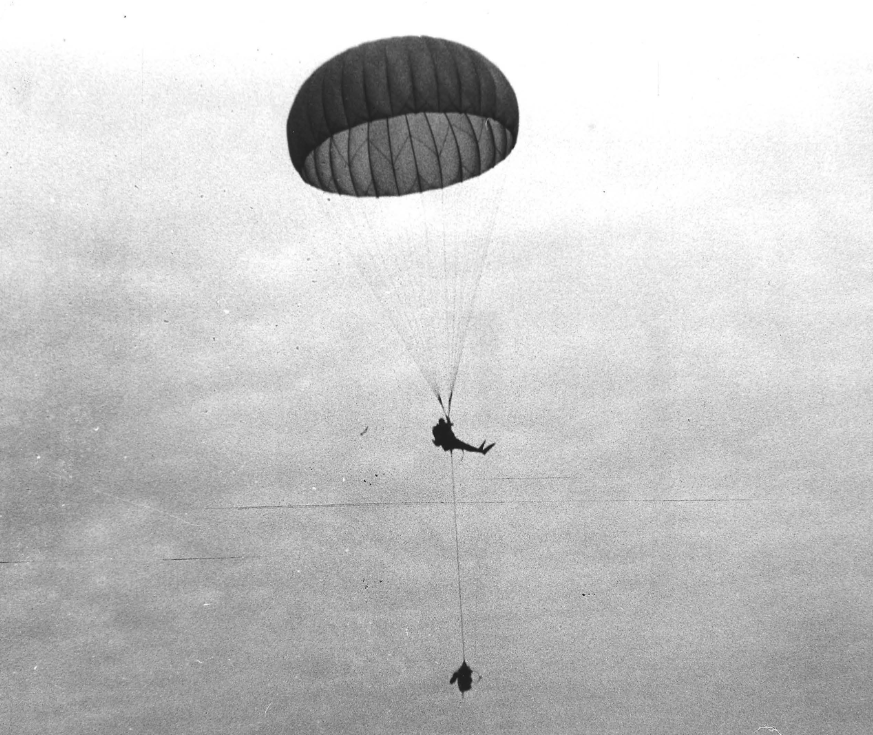
1966
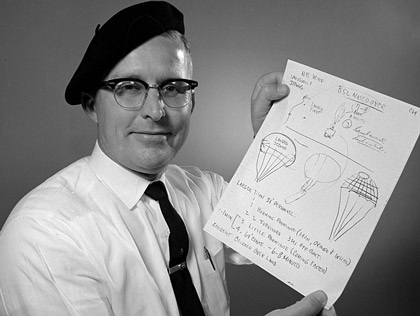
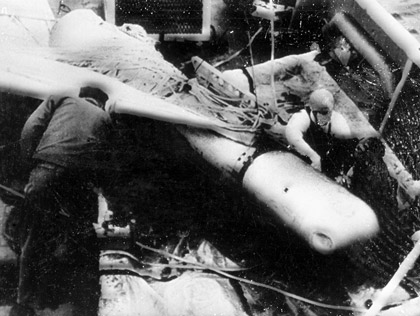
January 22, 1966
A B-52 with four B28 bombs collided with refueling tanker over Spain
B-52 carrying four B28 bombs collided with a KC-135 refueling tanker above Palomares, Spain. Four members of the B-52 crew parachuted to safety, but all of the tanker’s crew and three of the B-52’s crew were killed. The four B28 nuclear bombs, each equipped with both 16-foot diameter and 64-foot diameter parachutes, fell from the plane when it broke up. Three of the bombs landed on shore. The 16-foot parachute deployed on one, leaving it intact as it landed. A second bomb fell free and its high explosives detonated when it hit the ground. The third bomb’s 16-foot parachute partially deployed, but its high explosive also exploded. All three were located within hours and recovery operations began.
The fourth bomb was not immediately located, however. General Delmar Wilson, commanding the 16th Air Force, formed a joint Sandia-Air Force team to calculate possible trajectories for the bomb’s fall. Randy Maydew interviewed Spanish fisherman Francisco Simo Orts, who described seeing a dead man attached to a parachute falling from the aircraft immediately after the accident. The dead man turned out to be the missing weapon and the team was able to calculate the area for the search. On March 15, the small submarine Alvin located the bomb and, after an initial failed recovery effort, the cable-controlled underwater vehicle, CURV, retrieved it on April 7.
The recovered bomb casings of the first unexploded bomb and the one recovered from the Mediterranean are on display at the National Museum of Nuclear Science and History in Albuquerque, New Mexico.
October 1, 1966
John A. Hornbeck took over as Sandia Corporation President
A bold manager, John Hornbeck launched both operational and programmatic changes during his tenure. Sandia functions were reorganized, and he introduced a cost-control system modeled on one at Bell Laboratories that moved budget responsibilities from administrative support organizations to the line managers. Dr. Hornbeck also increased the technical depth at the Livermore site, adding an applied research organization there that focused in part on tritium research for gas reservoir designs. Although research and development money declined throughout the country, Hornbeck chose not to solicit additional programs, opting to let Sandia’s work sell itself and enhancing research capabilities in response to specific needs as they arose—for example, the Atomic Energy Commission’s initial investment in alternative energy, which became an ongoing line of business for Sandia.
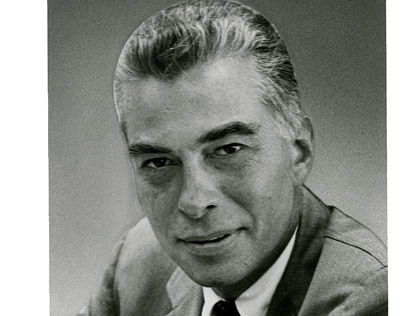
1969
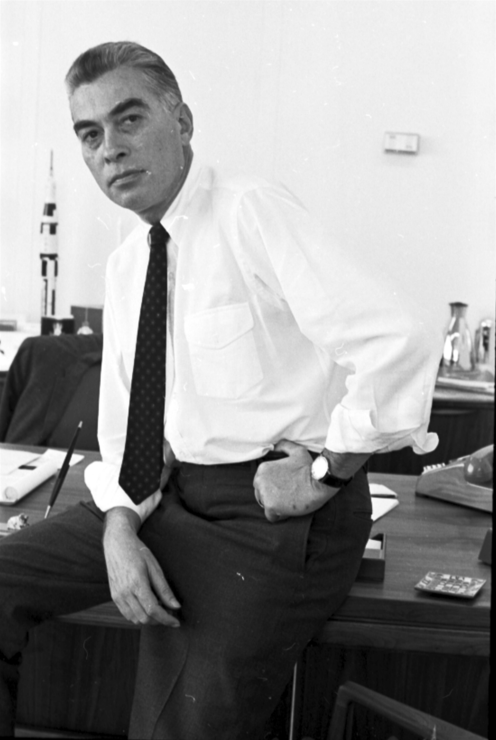
January 3, 1969
First State of the Labs interview published
In December 1968, Lab News editor John Shunny interviewed Lab Director John Hornbeck. It was an extended interview that probed different elements of Sandia’s activities, funding, and progress. The long interview with the lab director became an annual tradition identified as the State of the Labs. Later directors sat for the interview and gave State of the Labs presentations to employees and local dignitaries.